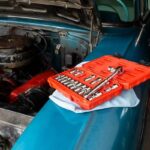The best tool for polishing car paint is undoubtedly a dual-action polisher like the Meguiar’s G100. However, these tools can be expensive, and many car owners might not have one readily available. For those seeking a more budget-friendly alternative, a Car Buffing Tool For Drill can be a viable option for addressing minor paint imperfections. While not ideal for large-scale paint correction, a drill can be effective for spot treatments and removing isolated scratches.
Using a Drill for Car Buffing: Benefits and Drawbacks
Using a car buffing tool attachment on a standard drill offers a practical solution for those who need to tackle minor paint issues without investing in a dedicated polisher. A drill’s readily available power and rotating action provides more cutting power than hand application, allowing for efficient removal of swirls and scratches in clear coat finishes. This makes it a convenient option for quick fixes.
However, using a drill for buffing does come with potential downsides. Drills operate with a direct drive rotating action, which increases the risk of creating swirl marks or even burning the paint if not used carefully. The high speed and direct drive can also cause certain polishing compounds, like ScratchX, to become gummy and difficult to remove if used over a large area. This is why it’s crucial to practice proper technique and choose the right products when using a drill for buffing.
Best Practices for Using a Car Buffing Tool for Drill
To minimize the risks associated with using a drill for buffing, consider these important tips:
-
Start with a Small Area: Begin by practicing on a less visible area to get a feel for the drill’s power and the product’s behavior. This will help you avoid making costly mistakes on more prominent panels.
-
Use Low Speed: Always use the lowest speed setting on your drill to minimize heat buildup and reduce the risk of burning the paint.
-
Keep the Pad Flat: Maintain consistent pressure and ensure the buffing pad remains flat against the paint surface to avoid creating uneven spots or swirl marks.
-
Work in Small Sections: Focus on small areas at a time, overlapping each pass slightly to ensure even coverage.
-
Choose the Right Product: Opt for polishing compounds specifically designed for machine use with a drill. These products are typically formulated to reduce gumming and minimize the risk of swirl marks.
When to Consider a Dual Action Polisher
While a car buffing tool for drill can be a helpful tool for minor paint correction, it’s not a substitute for a dual-action polisher. If you plan on performing more extensive paint correction or frequently detail your car, investing in a dual action polisher is recommended. These tools offer more control, reduced risk of paint damage, and generally deliver better results.
For isolated scratches and minor imperfections, a drill can provide a satisfactory solution. However, for larger areas or more serious paint issues, a dual-action polisher remains the superior choice.
Conclusion
A car buffing tool for drill offers a practical and cost-effective solution for addressing minor paint imperfections. While not a replacement for a dedicated dual-action polisher, it allows car owners with basic DIY skills to improve their car’s appearance. By following proper techniques and choosing the right products, you can safely and effectively remove minor scratches and swirls using a drill. However, always remember to prioritize safety and practice caution to avoid damaging your car’s paint.


